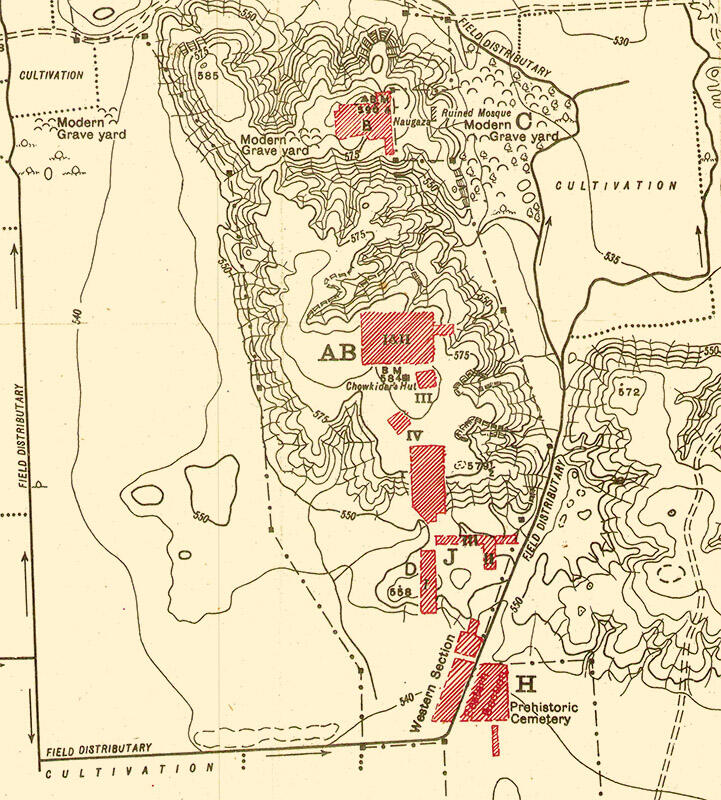"Due south of Mound F, and across the village road going west to the hamlet the highest of all the mounds at Harappa of Hafiz Bullah, stands Mound AB—(PI. I). Roughly, it is a parallelogram in shape, measuring some 1,450 ft. from north to south by 800 ft. from east to west. It rises quite abruptly above the surrounding plain, the contour lines, as will appear from the site plan (PI. I), following one another in quick succession along the slopes on all sides. Else- where at Harappa, such steep slopes are found only on Mound E. Crowning its north-east edge, and orientated from north to south, is the tomb of a Muhammadan saint named Nur Shah, constructed of bricks extracted from the ancient ruins. This tomb, enclosed by a brick wall, is 46 ft. long and 3 ft. 6 in. broad. From its size, it is known as the tomb of Naugaza.1 literally a man nine yards in stature. Not far from this, but at a higher level and apparently to the west, General Cunningham reported that he traced the remains of flights of steps on both the eastern and western faces of this mound, as well as the basement of a large square building.2 As none of these remains now exist it may be that they were dug away, after Cunningham’s time, for the sake of their bricks.
"During the last century, a light railway appears to have been constructed up to the mounds for carrying brick ballast, and I myself picked up a fish-plate belonging to this railway on the east bank of the modern irrigation distributary shown between Mounds AB and E (PI. I). This and the neighbouring Mound E have sufiered most from brick-diggers. According to Cunningham,3 bricks from Harappa were converted into more than 100 miles of railroad ballast, and the extent to which this mound was exploited can be gauged from the two large ravines which were cut almost across its entire width from east to west, as well as from other large ravines on the north and south, not to mention innumerable smaller entrenchments and tunnels sunk in every direction. And in this connection it may also be observed that the prosperous little town of Harappa, with a population of about 3,000, and houses4 chiefly of burnt brick, came to possess its first brick kiln only after the mounds had been brought under the protection of the Ancient Monuments Preservation Act in 1920.
"The two east to west ravines, referred to above, divide this mound into three parts, of which the middle one, lying between the two ravines is the smallest. In the middle and southern sections, which are connected by a narrow neck, there is an irregular eminence indicated by the 580 ft. contour fine, and in the northern section there is one eminence a few feet higher near the north-western edge of the mound, and another one still higher between this and the Naugaza tomb (590 ft. above the mean sea-level)."
- Madho Sarop Vats, Excavations at Harappa, Delhi, 1940, pp. 136.
1. The word Naugazd is also intei-preted by some people as Naughazi or new victor in the cause of Islam.↩
2. C. S. B., Vol. V, p. 106.↩
3. Letter from Vogel to Cousens of 21 August 1906, no. 13 (1-11) of 1906, ASI, quoted in Lahiri, p. 386 Endnotes.↩
4. These houses are one, two, and sometimes even three storeys high.↩

